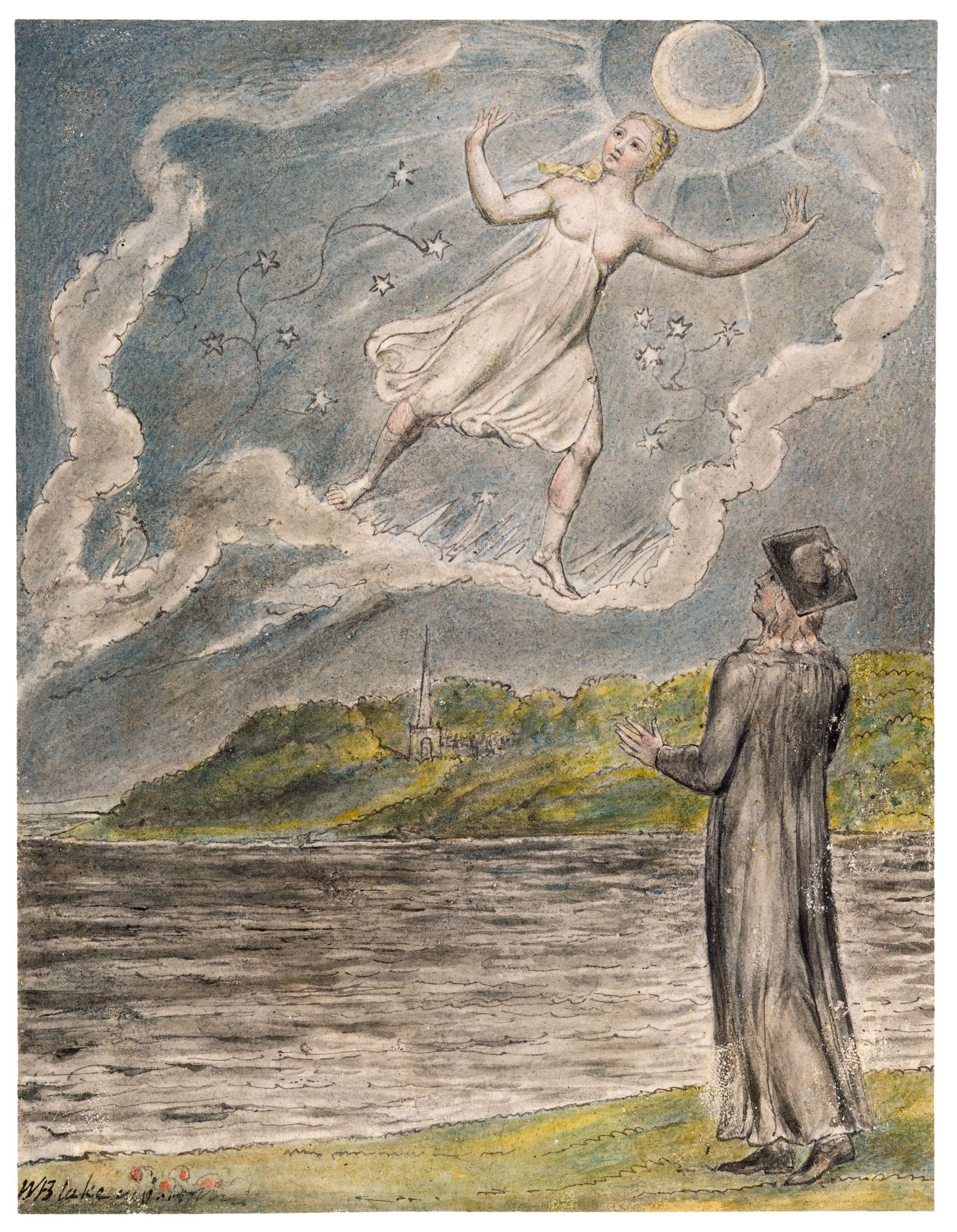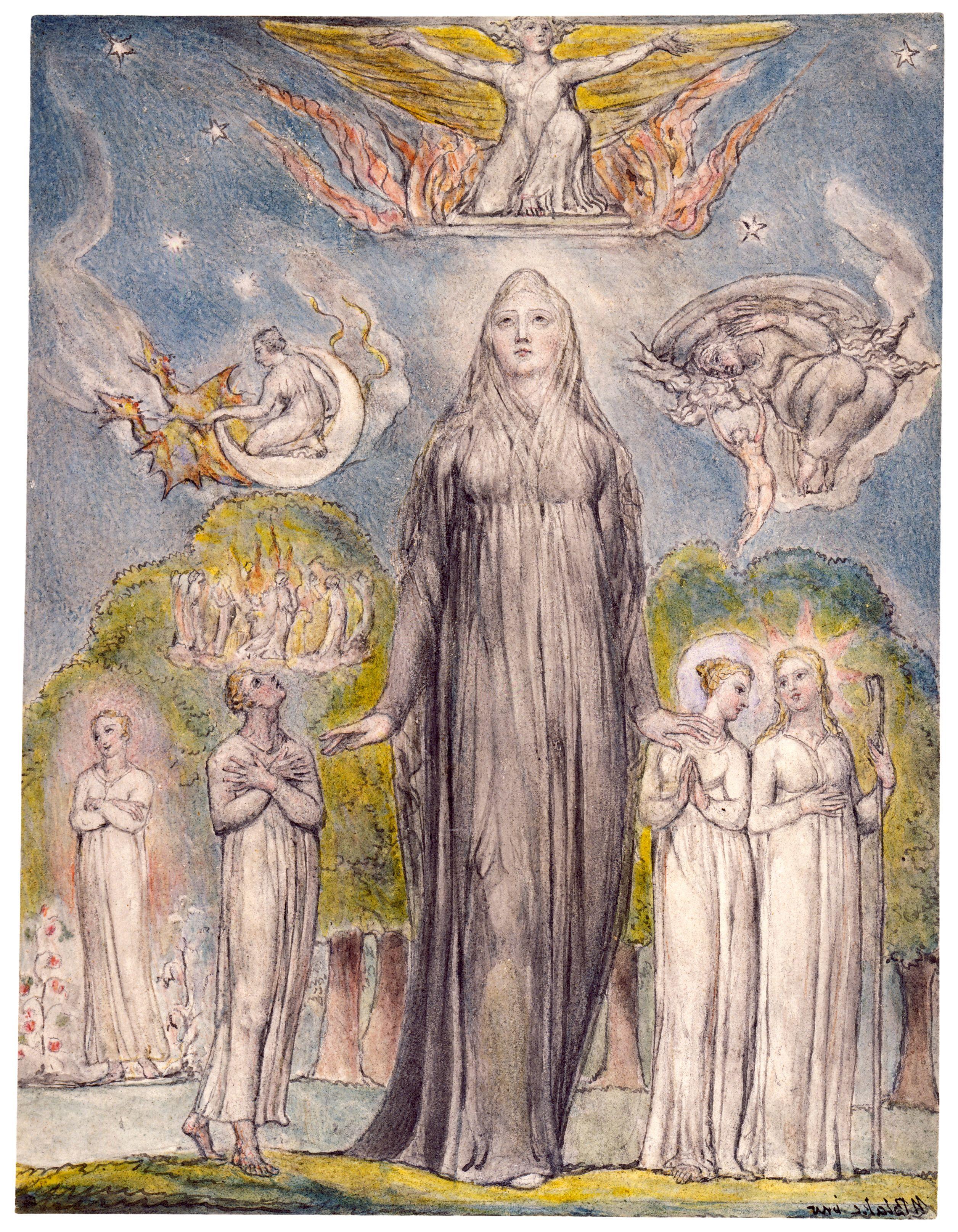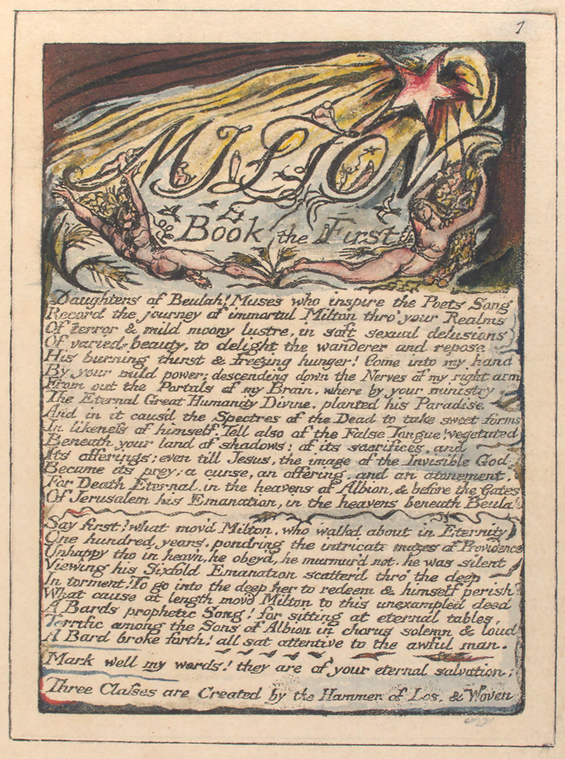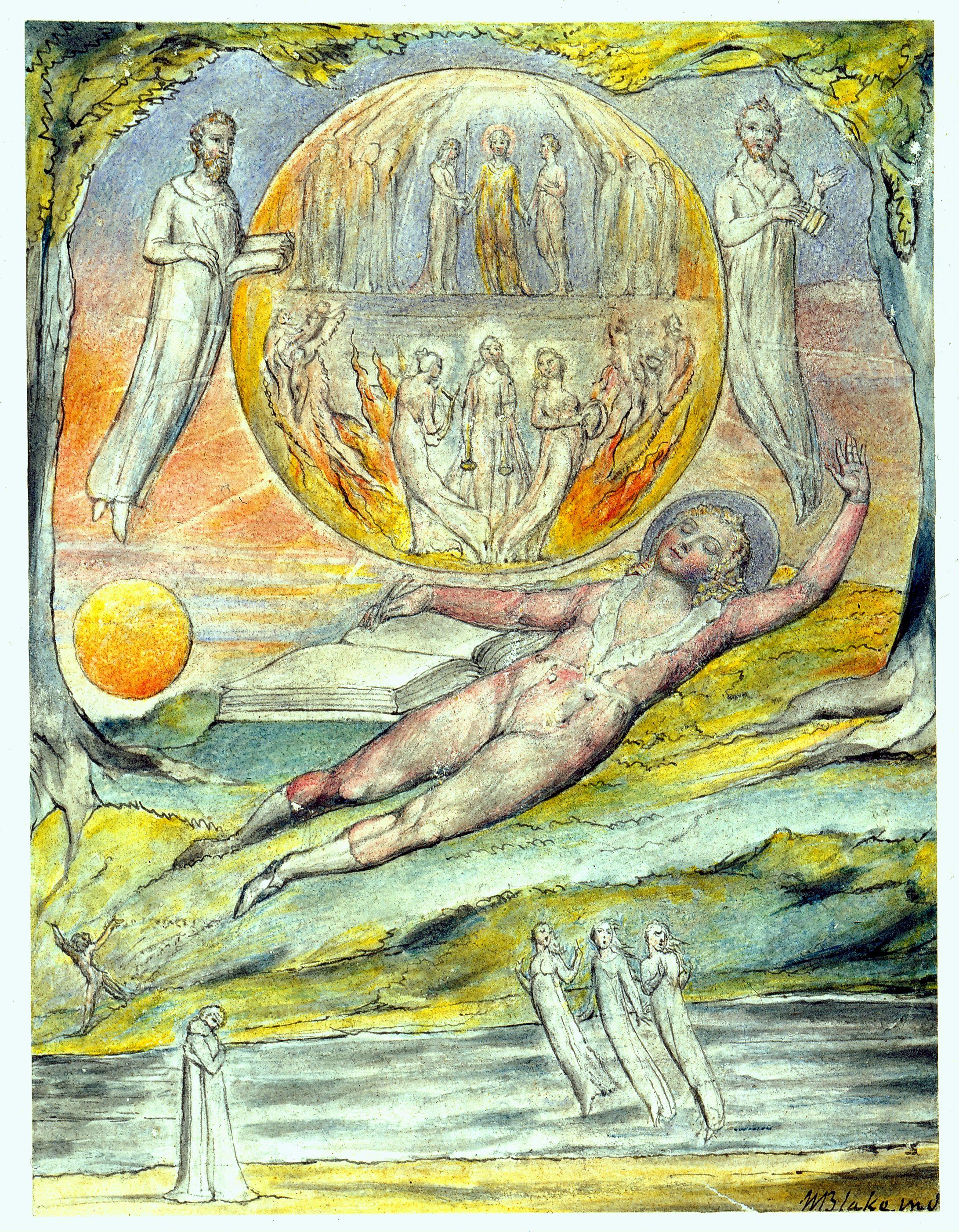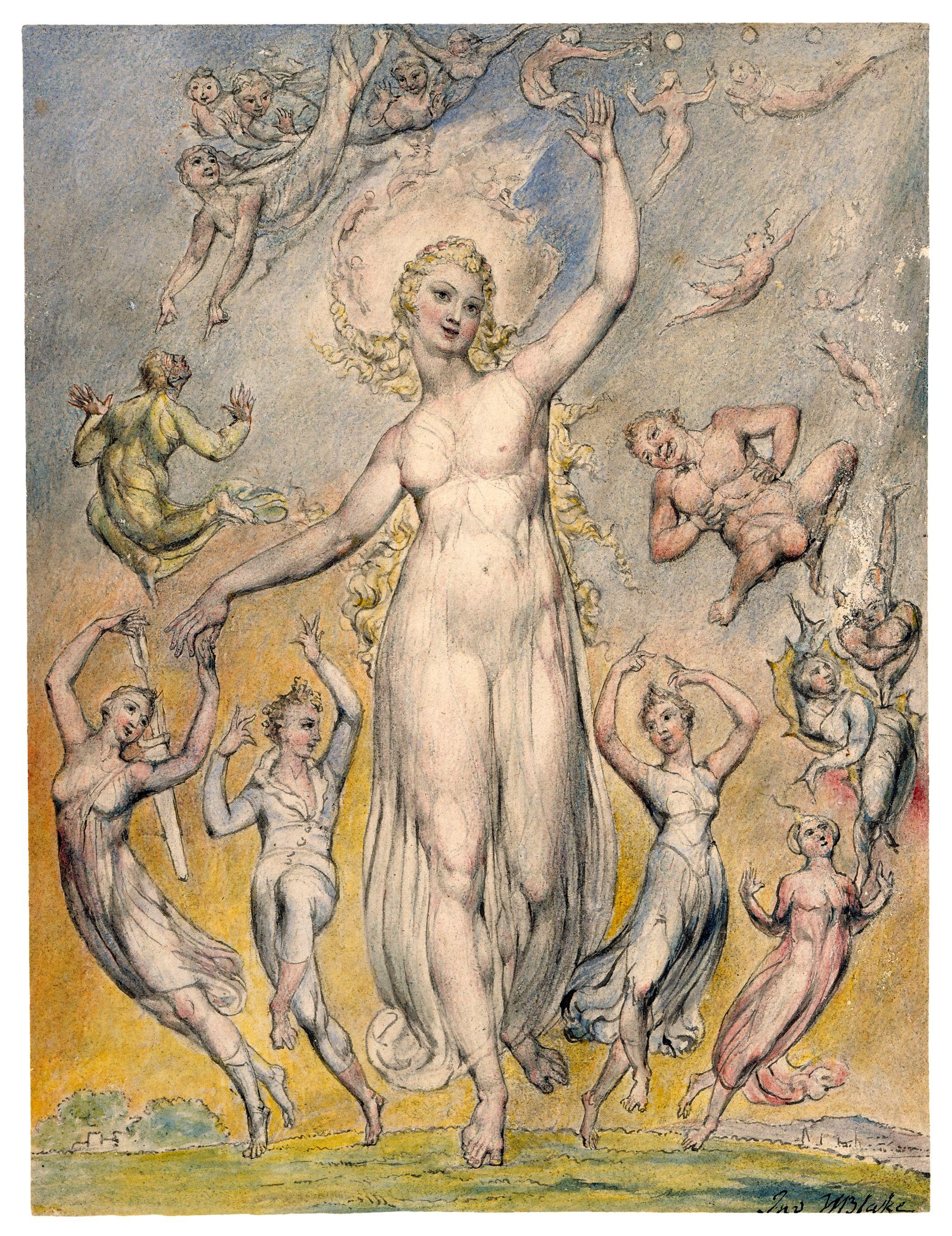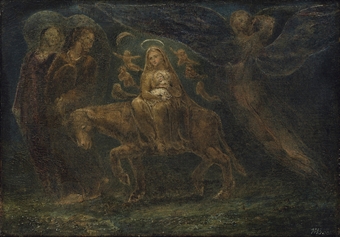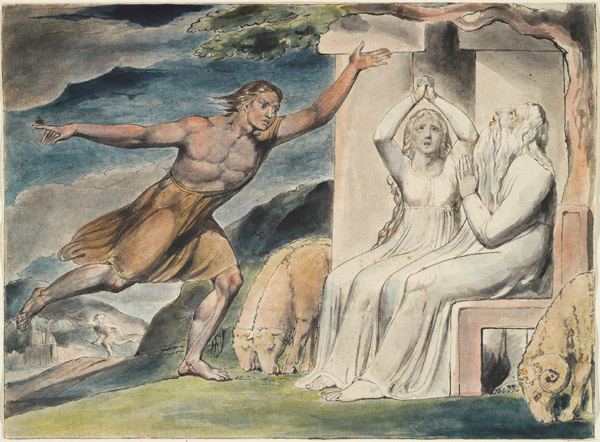Descriptions of Illustrations to Milton's L'Allegro and Il Penseroso (E 684)
"Where I may oft outwatch the Bear
With thrice great Hermes or unsphear
The Spirit of Plato to unfold What
Worlds or what vast regions hold
The Immortal Mind that has forsook
Its Mansion in this Fleshly nook
And of those Spirits that are found
In Fire. Air. Flood. & Underground"
Blake wrote:
"The Spirit of Plato unfolds his Worlds to Milton in Contemplation. The Three destinies sit on the Circles of Platos Heavens weaving the Thread of Mortal Life these Heavens are Venus Jupiter & Mars, Hermes flies before as attending on the Heaven of Jupiter the Great Bear is seen in the Sky beneath Hermes & The Spirits of Fire. Air. Water & Earth Surround Miltons Chair"
As in the previous illustration, Milton himself is included in the picture. He sits in the chair contemplating the images which arise in his 'Immortal Mind' as the constellation, the 'Bear', makes his nightly journey circling the pole. 'The Spirits of Fire. Air. Water & Earth' are seen in order: on the left margin, above Milton's head, behind Milton's chair, and along the bottom of the picture. Each of these is presented in rather unattractive aspects. The Spirit of Plato is the dominant figure standing before the bowed Milton, while the three fates dispense the thread of life at the top of the picture. Hermes wearing his winged cap observes the occupants of the three globes.
The three heavens of Venus, Mars and Jupiter are not mentioned by Milton. Blake adds them to emphasise what he considered erroneous teachings of Plato which he found contrary to the teachings of Jesus. Venus is a symbol for sexual dominance, Mars is a symbol for military power, Jupiter is a symbol for political authority. The militaristic culture of the Greeks and the Romans who followed them failed to incorporate the concept of forgiveness of sin which to Blake was essential to the development of man into the full Image of God which was his potential and his destiny.
The issues and ideas in Greek culture with which Blake struggled himself are presented in this illustration as occupying the thoughts of Milton in his midnight contemplation.
Song of Los, Plate 3, (E 67) "To Trismegistus. Palamabron gave an abstract Law: To Pythagoras Socrates & Plato."
Milton, Plate 1, (E 95)
"The Stolen and Perverted Writings of Homer & Ovid: of Plato &
Cicero. which all Men ought to contemn: are set up by artifice
against the Sublime of the Bible. but when the New Age is at
leisure to Pronounce; all will be set right: & those Grand Works
of the more ancient & consciously & professedly Inspired Men,
will hold their proper rank, & the Daughters of Memory shall
become the Daughters of Inspiration. Shakspeare & Milton were
both curbd by the general malady & infection from the silly Greek
& Latin slaves of the Sword."
Milton,
Plate 22 [24], (E 117)"And all the Daughters of Los prophetic wail: yet in deceit, They weave a new Religion from new Jealousy of Theotormon! Miltons Religion is the cause: there is no end to destruction! Seeing the Churches at their Period in terror & despair: Rahab created Voltaire; Tirzah created Rousseau; Asserting the Self-righteousness against the Universal Saviour, Mocking the Confessors & Martyrs, claiming Self-righteousness; With cruel Virtue: making War upon the Lambs Redeemed; To perpetuate War & Glory. to perpetuate the Laws of Sin: They perverted Swedenborgs Visions in Beulah & in Ulro; To destroy Jerusalem as a Harlot & her Sons as Reprobates; To raise up Mystery the Virgin Harlot Mother of War, Babylon the Great, the Abomination of Desolation! O Swedenborg! strongest of men, the Samson shorn by the Churches! Shewing the Transgresors in Hell, the proud Warriors in Heaven: Heaven as a Punisher & Hell as One under Punishment: With Laws from Plato & his Greeks to renew the Trojan Gods, In Albion; & to deny the value of the Saviours blood."
Laocoon, (E 274) "There are States in which all Visionary Men are accounted Mad Men such are Greece & Rome"
Annotations to Watson, (E 619)
"The Gospel is Forgiveness of Sins & has No Moral Precepts these belong to Plato & Seneca & Nero"
Annotations to Berkley, (E 664)
"Knowledge is not by deduction but Immediate by Perception or
Sense at once Christ addresses himself to the Man not to his
Reason Plato did not bring Life & Immortality to Light Jesus
only did this
...
Jesus supposes every Thing to be Evident to the Child & to
the Poor & Unlearned Such is the Gospel
The Whole Bible is filld with Imaginations & Visions from
End to End & not with Moral virtues that is the baseness of Plato
& the Greeks & all Warriors The Moral Virtues are continual
Accusers of Sin & promote Eternal Wars & Domineering over others
...
What Jesus came to Remove was the Heathen or Platonic
Philosophy which blinds the Eye of Imagination The Real Man"
The Everlasting Gospel, (E 875)
"There is not one Moral Virtue that Jesus Inculcated but Plato &
Cicero did Inculcate before him what then did Christ Inculcate.
Forgiveness of Sins This alone is the Gospel & this is the Life &
Immortality brought to light by Jesus. Even the Covenant of
Jehovah, which is This If you forgive one another your Trespasses
so shall Jehovah forgive you That he himself may dwell among you
but if you Avenge you Murder the Divine Image & he cannot dwell
among you [by his] because you Murder him he arises
Again & you deny that he is Arisen & are blind to Spirit
...
What can this Gospel of Jesus be
What Life Immortality
What was [It] that he brought to Light
That Plato & Cicero did not write
The Heathen Deities wrote them all
These Moral Virtues great & small
What is the Accusation of Sin
But Moral Virtues deadly Gin"
.

